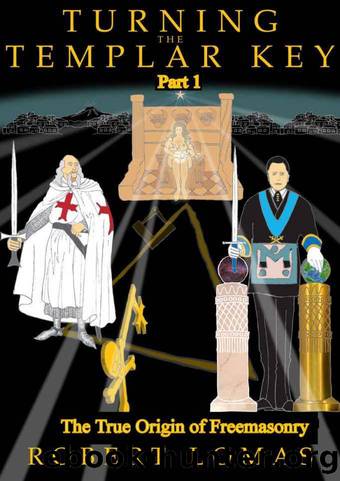Turning The Templar Key - Part 1: The True Origin of Freemasonry by Lomas Robert

Author:Lomas, Robert [Lomas, Robert]
Language: eng
Format: epub
Publisher: QCS eBooks
Published: 2012-02-23T21:00:00+00:00
Viking America
It was another fifteen years before Leif, Erik the Redâs eldest son, made his first landings in the New World. The Greenland Saga (GrÅnlendinga Saga) tells how hard it was to set up a functioning colony in Greenland, with few ships to carry materials from Europe to support the colonists. It is hardly surprising that it was not until the Greenland colony was stable and able to feed itself that the Greenlanders found enough spare time to investigate his findings.[ Foote, P.G., and D.M. Wilson (1970) p xxii.] Gwyn Jones explains that Bjarniâs account was accepted, but there were simply no resources available to investigate Markland, Woodland, and Vinland, as he called them:
There was no question of them not believing him. Medieval geography favoured the notion of more land to be found beyond Greenland and, more practically, when men climbed high mountains they could see the far distant land itself or the cloud formations they associated with land.
[Jones (2001) p. 298.]
The implication of these facts is that Norse sailors were exploring the lightly populated coasts of North America with a view to colonization about a hundred years before Christian Europe came up with the idea of Holy Violence as a way to justify colonizing the heavily populated Holy Land. This does rather negate the idea that Columbus discovered America in 1492. But exactly where did the Vikings get to? It was an Icelander, Thorfinn Karlsefni, who set up the first trading colony on Vinland in the early years of the eleventh century. Gwyn Jones says:
While there is general agreement that the Norsemen reached North America, agreement does not extend to how far south they reached. An increasing weight of opinion has now settled for southern Baffin Island as Helluland, Labrador south of Nain as Markland, but Vinland, Wineland, where the voyagers are said to have found grapes and wheat growing wild, is a different story. The St Lawrence Estuary, Baie de Chaleur, New Brunswick, Nova Scotia, New England, Massachusetts, Rhode Island, Long Island Sound, Virginia, Georgia, and Florida have been argued for with acumen and eloquence . . . Maybe it was as a result of far-ranging voyages . . . that tales of grape-clusters, self-sown wheat, and kindly winters enriched the Norse tradition of Vinland; maybe longer voyages and later travellers blurred the outlines of Leifâs landing and Karlsefniâs settlement . . . Bishop Eirik sailed there in a year variously stated to be 1112, 1113, 1117, and, most probably, 1121, with what result we do not know. As late as the middle of the fourteenth century men were still sailing there, presumably to fetch timber and furs. The Icelandic Annals record that in the year 1347 a ship with seventeen or eighteen Greenlanders on board was storm-driven to Iceland as they sought to return to their own country from Markland. But after that there was silence.
[Jones (2001) p. 299.]
Jared Diamond agrees with this, and goes further:
The coast of northeastern North America . . . lies thousands of miles from Norway .
Download
This site does not store any files on its server. We only index and link to content provided by other sites. Please contact the content providers to delete copyright contents if any and email us, we'll remove relevant links or contents immediately.
| Baha'i | Cults |
| Demonology & Satanism | Eckankar |
| Egyptian Book of the Dead | Freemasonry |
| Messianic Judaism | Mysticism |
| Scientology | Theism |
| Tribal & Ethnic | Unitarian Universalism |
The Four Agreements by Don Miguel Ruiz(6641)
Breaking Free by Rachel Jeffs(4176)
The Hatha Yoga Pradipika (Translated) by Svatmarama(3235)
120 Days of Sodom by Marquis de Sade(3185)
Member of the Family by Dianne Lake(2303)
The Tao of Physics by Fritjof Capra(2231)
The Psychedelic Gospels: The Secret History of Hallucinogens in Christianity by Jerry B. Brown(2122)
The Road to Jonestown by Jeff Guinn(2021)
Going Clear: Scientology, Hollywood, and the Prison of Belief by Lawrence Wright(1940)
Going Clear by Lawrence Wright(1927)
Uriel's Machine by Christopher Knight(1866)
The Grand Grimoire: The Red Dragon by Author Unknown(1761)
The Gnostic Gospel of St. Thomas by Tau Malachi(1739)
Key to the Sacred Pattern: The Untold Story of Rennes-le-Chateau by Henry Lincoln(1596)
The Malloreon: Book 02 - King of the Murgos by David Eddings(1562)
Waco by David Thibodeau & Leon Whiteson & Aviva Layton(1531)
The New World Order Book by Nick Redfern(1527)
Animal Speak by Ted Andrews(1522)
The Secret of the Temple by John Michael Greer(1467)
